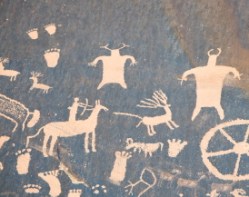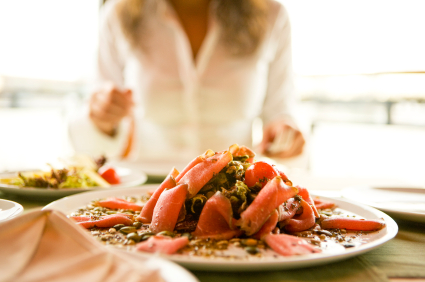 “Live long, drop dead!” is the motto of the primal living crowd, a group of motley 20- to 60-somethings who gathered this spring in Oxnard, Calif., for PrimalCon, a weekend of nutrition education, “natural exercise,” cooking demos, and low-carb feasting.
“Live long, drop dead!” is the motto of the primal living crowd, a group of motley 20- to 60-somethings who gathered this spring in Oxnard, Calif., for PrimalCon, a weekend of nutrition education, “natural exercise,” cooking demos, and low-carb feasting.
Mark Sisson is the blonde, buff leader of this crowd, which had gathered based on its interest in the “paleo” or “caveman” diet. Sisson is a blogger and the founder of a nutrition company who has sold close to half a million copies of his self-published Primal Blueprint and has since released a series of additional guidebooks and cookbooks. In a nutshell — and nuts are key here — primal living is popular. But is it green? I tried out the diet and attended PrimalCon in an effort to find out.
Primal 101
The theory behind living long and dropping dead is simple, if a bit reductionist. The reason we Westerners get fat, sluggish, and sick, spending our final days wasting away in wheelchairs, is because we’ve been disconnected from our evolutionary program, or “primal blueprint.”
“We live in a very different world from our evolutionary roots,” says Sisson. “Luckily there is a map to flourish very deep in our hunter-gatherer genes.”
According to Sisson and other primal advocates, homo sapiens were “designed by evolution” to be roaming around barefoot, moving frequently, hunting, gathering, and socializing in tight-knit groups. Before the dawn of agriculture and civilization, we would eat only wild meat, vegetables, fruits, nuts, and seeds. Grains and legumes were scarce, and processed foods hadn’t been invented yet. The emphasis on high-fat, low-carb foods is similar to the Atkins diet, but the primal diet cuts out all grains and refined oils and is more holistic — including recommendations for specific exercise, sleeping habits, and other behaviors.
Sisson believes that our genetic makeup hasn’t changed much in the last 10,000 years, which means the same foods are still optimal for our health. Much of this premise has been disputed — as the narrator of this series of videos critical of the lifestyle says, “selling nutritional supplements online to support a primitive lifestyle requires more than just a few intellectual contortions.” But it is clear that cavemen didn’t subsist on Doritos, pizza, Pepsi, and Oreos. And this was probably good.
And unlike today’s recommended cardio regime, Paleolithic exercise came in sporadic, intense bursts of activity (like when we were spearing woolly mammoths or getting chased by pumas). Our movements were agile, and executed with efficiency. From the photos that the primal authors publish, it also looks like we were seriously ripped. When our departure time came, the reaper took us out with a flash flood, a quick infection, or a bear attack. No statins, transplants, or hospices: We just dropped dead.
Of course it’s impossible to live like Paleolithic humans in 21st-century America, and some scholars say it’s even impossible to get (or stomach) the same foods that they ate. Tom Neuhaus, who teaches nutrition at California Polytechnic University, says that early humans certainly ate insects, and different species of plants. “Foods available today are nothing like those of the past, when carrots were blue (colored with anthocyanins) and not so sweet, and apples were sour and rich in healthful polyphenols. To adopt a truly paleolithic diet, we would have to find the old varieties and replant them. Not so easy,” he said.
 So the primal folks offer contemporary adaptations that approximate our best knowledge of caveman consumption. It’s hard to argue with cutting out processed and refined foods, but, from an environmental perspective, grains and legumes also require fewer resources and less energy to produce than most caveman food did. And advocating that everyone eat copious amounts of animal products can even be seen as irresponsible, given the consequences for our water supply, carbon emissions, and farmlands. “For every pound of filet mignon on your plate, it takes 30 pounds of grain and 1,200 gallons of water, so that’s an extraordinarily inefficient way to make protein,” said University of Minnesota Ecology Professor Jonathan Foley.
So the primal folks offer contemporary adaptations that approximate our best knowledge of caveman consumption. It’s hard to argue with cutting out processed and refined foods, but, from an environmental perspective, grains and legumes also require fewer resources and less energy to produce than most caveman food did. And advocating that everyone eat copious amounts of animal products can even be seen as irresponsible, given the consequences for our water supply, carbon emissions, and farmlands. “For every pound of filet mignon on your plate, it takes 30 pounds of grain and 1,200 gallons of water, so that’s an extraordinarily inefficient way to make protein,” said University of Minnesota Ecology Professor Jonathan Foley.
No carb, but lots of carbon
Lunch time at PrimalCon offered the best opportunity to sample the core of this tribe’s philosophy. After standing in a slow-moving line of 100 hungry cave people, I tucked into a plate of free-range turkey legs, boiled eggs, organic berries, celery, carrot sticks, and a generous dollop of macadamia nut butter that I had scooped out from a 17-pound tub. Delicious. It’s this plate that primal advocates believe is going to heal the world.
Their claims have to do mostly with bucking the conventions of the standard American diet. The health studies Sisson presents in Primal Blueprint point to the over-production of insulin, induced by overloading with carbs and sugar, as the true culprit in our obesity and diet-related disease epidemic. It’s not the fat or excess protein that’s killing us, he says — it’s the bread, rice, pasta, potatoes, beans, and processed sweets that jack up our blood insulin levels, causing a cascade of reactions that make us susceptible to diabetes, heart disease, cancer, and even the common cold.
In stark contradiction to what the United States Dept. of Agriculture tells us, Sisson claims that the saturated fat that’s found in red meat, avocados, coconuts, and butter is good for us, and promotes the optimal expression of our genes, realigning us with our ancestral path to health. The studies he cites show no relationship between blood cholesterol levels and heart disease, so he advocates copious amounts of eggs, avocados, nuts, and meats. And that’s one of the biggest problems with the paleo diet — there’s no vegetarian option.
The stereotypical image of the caveman gnawing on animal bones actually rings true here; Sisson admits to having a steak daily. “I eat the fat off a ribeye and give the lean part to my dog,” he told the audience at PrimalCon.
To Sisson’s credit, he only recommends eating beef, poultry, lamb, and pork that is pasture-raised and organic. And while it’s unlikely that the estimated million or so people who adhere to the paleo diet are following that recommendation all the time, it is noteworthy that the diet does not simply advise you to pile your grocery cart high with cheap industrial meat.
And Toby Hemenway, author of Gaia’s Garden, says the paleo diet’s approach to pasture-raised meat does have its ecosystem benefits. “We know how to raise livestock so they solve environmental problems instead of creating them,” he said. “Rotational grazing, for example, helps build soil fertility.”
But Foley still doesn’t think it makes sense to base a whole diet around any kind of meat, pasture-raised or not. After all, he points out, “there is only so much land that can be used for grazing, and then with grass-fed meat, the cows are actually producing more of the greenhouse gas methane than the grain-fed cows are, due to the fact that they live longer,” he said.
While the paleo reasons for promoting pastured meat are nutritional — Sisson believes animals fed their natural diet and allowed to exercise produce meat that has fewer inflammatory omega-6s and hormones — the end result is that at least some primal practitioners are likely making a move toward supporting sustainable farms and ranches.
Sisson also claims that the daily caloric intake on the paleo diet is lower than average, making it more sustainable in general. “We can feed the world if everyone cut out 600 calories,” he declared during his post-lunch PrimalCon lecture. But when half the world’s population depends on rice for their survival, it seems that he’s got an uphill battle. Clearly not everyone on the planet can eat like he does.
Forget about the beef — just imagine providing enough macadamia nuts for 7 billion people.
After a weekend of primal eating and exercise, I could see why people “go primal.” Those who have been doing it for a while look really good. And it teaches you all kinds of new skills. During a break between sprints on the beach — which are said to be much better for you than long, “chronic” cardio workouts — one woman instructed the crowd on the best way to chop into a coconut, while another guy explained, between kettle ball reps, how to keep your fridge functioning like a salad bar.
On the other hand, you’ve also got to remain constantly vigilant, refusing nearly everything your friends and family are eating. There’s also the fact that if you care about the fate of the world beyond your own body, you’ll probably find yourself struggling for answers sooner or later. And in the end? You might just drop dead either way.



